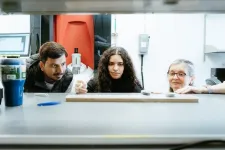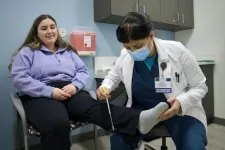(Press-News.org)
The University of Southern California has been approved for $10.8 million in research funding by the Patient-Centered Outcomes Research Institute (PCORI) to compare approaches to treating older adults with a fracture of the hip. Led by principal investigator Joseph Patterson, MD, an orthopaedic surgeon specializing in fracture care at Keck Medicine of USC, the “FASTER-Hip” trial aims to determine whether patients with a certain type of hip fracture fare better with a hip replacement or a simpler surgery known as internal fixation.
The trial leadership team includes co-principal investigators Gerard Slobogean, MD, director of clinical research for the Department of Orthopaedics at University of Maryland School of Medicine, and Sheila Sprague, PhD, research director in the Department of Surgery at McMaster University in Ontario, Canada.
Each year, more than 5 million older adults around the world suffer hip fractures, which can be debilitating and sometimes fatal. One common type of hip fracture, a femoral neck fracture, involves the neck of the femur bone in the upper thigh. One in five femoral neck fractures is minimally displaced, meaning the bone is broken but the pieces remain in close contact or are only slightly separated.
For decades, surgeons have mainly used internal fixation to repair these minimally displaced fractures. This easier, shorter procedure uses metal screws and plates to stabilize the bone while it heals. Compared to hip replacement, internal fixation is less invasive and carriers a lower risk of certain complications, such as dislocation and infection. But new data indicate that the procedure is no panacea: 14% of patients who receive internal fixation eventually need another operation, such as a hip replacement.
“If we go directly to hip replacement in these cases, that’s a bigger operation. It takes more time, there’s more blood loss, and the complications are different,” said Patterson, who is also director of orthopaedic trauma research in the Department of Orthopaedic Surgery and assistant professor at the Keck School of Medicine of USC. “Surgeons have strong feelings about these two procedures. We want to know what the evidence shows. Is starting with the larger surgery better for these patients?”
Patterson and his team at USC will administer the clinical trial, which will enroll 600 patients, ages 60 and older, from 32 clinical sites across the United States, Canada and Europe. Sprague will oversee the trial’s methods center and infrastructure. Slobogean will oversee protocol and patient engagement aspects of the trial.
A focus on patients
Most clinical trials in orthopaedic surgery focus on outcomes that matter to surgeons, insurers and health care systems. These include whether patients survive, get readmitted to the hospital or require additional surgery.
“Where this trial differs: We have assembled and will continue to work with a core group of patient stakeholders, as well as everyone who touches the patient throughout their recovery,” Patterson said.
He and his team have recruited patients, family members, geriatricians, rehabilitation professionals (such as physical and occupational therapists), and representatives from insurance companies and professional societies. The group will convene several times per year throughout the trial to ensure researchers are collecting data that patients care about.
The patient-focused approach is central to PCORI, an independent, nonprofit organization with a mission to fund patient-centered comparative clinical effectiveness research (CER). CER provides patients, their caregivers and clinicians with the evidence-based information they need to make better-informed health and health care decisions.
“Already, our engagement with patients and their caregivers has revealed outcomes that matter to them, outcomes which differ from the ones we tend to think about as surgeons and epidemiologists,” Patterson said.
In addition to survival and avoiding additional surgeries, patients value going home, living independently, and regaining the ability to walk.
Guiding medical practice
The findings of the comparative effectiveness research study could inform clinical guidelines, which are recommendations that help clinicians, patients and their caregivers make decisions about care.
Most societies reevaluate clinical evidence every one to two years and adjust their guidelines as needed. Several leading groups—including the Orthopaedic Trauma Association, the American Academy of Orthopaedic Surgeons, and the American Association of Hip and Knee Surgeons—have already expressed support for the trial.
Findings from the research can help patients and their providers make the choice that is right for them. For example, some patients place a high priority on living independently, while others may prefer to avoid a second surgery.
“Our goal is to generate the evidence that surgeons around the world can use to have conversations with patients and their family members about how best to achieve their goals,” Patterson said.
This award has been approved pending completion of PCORI’s business and programmatic review and issuance of a formal award contract. To learn more about the project, visit the PCORI website.
END
CLEVELAND -- University Hospitals Cleveland Medical Center is one of the most recognizable hospitals among doctors in the U.S. and around the world, according to an annual survey.
UH Cleveland Medical Center was ranked eighth in the U.S. and 16th globally in a survey of the strongest Academic Medical Center brands, according to Brand Finance, a London-based brand valuation consultancy.
“This ranking is a reflection of all we do at University Hospitals to provide compassionate care for patients, work to find the next generation of therapies and treatments, invest ...
Rice University physicist Emilia Morosan is part of an international research collaboration that has been awarded multimillion-dollar funding from The Kavli Foundation to develop and test next-generation superconductors through artificial intelligence and quantum geometry. This global initiative, spearheaded by Päivi Törmä of Aalto University in Finland, seeks to push the boundaries of quantum materials science and superconductivity.
The project includes funding from the Klaus ...
Researchers from Imperial College Business School and University of Leeds published a Journal of Marketing study that examines the impact of BNPL installment payments on retail sales. The study, forthcoming in the Journal of Marketing, is titled “Buy Now Pay Later: Impact of Installment Payments on Customer Purchases” and is authored by Stijn Maesen and Dionysius Ang.
Buy-Now-Pay-Later (BNPL) is an increasingly popular payment method, allowing customers to spread payment into interest-free installments over a few weeks or months. Worldwide ...
Professor Leslie Wolf, a Distinguished University Professor and Ben F. Johnson Jr. Chair in Law at Georgia State University College of Law, is a part of a research team that has been provided $1.9 million to conduct research designed to increase participation in biomedical studies by involving participants in the research design process. The award has been approved pending completion of a business and programmatic review by PCORI staff and issuance of a formal award contract.
Wolf, along with colleagues at the ...
Biochar: bridging a gap in carbon removal strategies
As the world works to meet net-zero carbon goals, a new study offers a critical reminder: precision matters. The researchers suggest refining how we assess a natural carbon storage strategy to ensure the technology lives up to its potential as a climate change solution.
Biochar, a charcoal-like material derived from plant biomass, has long been hailed as a promising tool for carbon dioxide removal. However, a new study by Stanford researchers highlights a critical issue: current methods for assessing biochar's carbon storage potential may significantly undervalue its true ...
A new study shows how an anticancer drug triggers an “outside in” signal that gets it sucked into a cancer cell. The work, published Jan. 29 in Nature Communications, reveals a new signaling mechanism that could be exploited for delivering other drugs.
Many malignant cancers overexpress a protein called P-cadherin, which is embedded in the cell membrane. Because cancer cells have a lot of P-cadherin sticking out of their surface, the protein has been targeted for drug development.
Monoclonal antibodies against P-cadherin can carry a drug payload to the cancer cells. It has not been clear, though, exactly how the antibodies attach to P-cadherin ...
NEW ORLEANS, Feb. 4, 2025 — The American Heart Association, a global force changing the future of health, is promoting water safety, a multi-market priority initiative for the Off the Field National Football League Wives Association. The American Heart Association provided Hands-Only cardiopulmonary resuscitation (CPR) and automated external defibrillator (AED) education as part of the safe swim event held at Tulane University’s Reily Center on Tuesday, Feb. 4. The event welcomed nearly ...
TAMPA, Fla. (Feb. 4, 2025) — A new community-based pickleball program called Project Rally is helping cancer survivors improve their physical and social well-being, according to a recent pilot study led by researchers at Moffitt Cancer Center. The program, which is offered in partnership with the YMCA of the Suncoast, has shown strong results in terms of participation, enjoyment, and physical improvements.
Staying active is a key part of cancer survivorship care and research. Physical activity can help reduce the negative effects of cancer and its treatments, while also empowering survivors to live fulfilling lives. It offers many ...
The first participants in an international clinical trial aimed at preventing Alzheimer’s disease in young adults at high risk of the disease have been enrolled. The trial, led by Washington University School of Medicine in St. Louis, aims to determine whether stopping the early molecular changes that lead to symptomatic Alzheimer’s disease can prevent the disease from ever taking hold. The study is enrolling people as young as 18 who have few or no detectable Alzheimer’s-related molecular changes in their brains, up to 25 years before the expected onset ...
Ever notice that batteries in electronics don't last as long as they did when they were brand new?
An international research team led by The University of Texas at Austin took on this well-known battery challenge, called degradation, with a twist. They're focusing their work on real-world technology that many of us use daily: wireless earbuds. They deployed x-ray, infrared, and other imaging technologies to understand the complexities of all the technology packed in these tiny devices and learn why their battery lives erode over time.
"This started with my personal headphones; I only wear the right one, and I found ...




